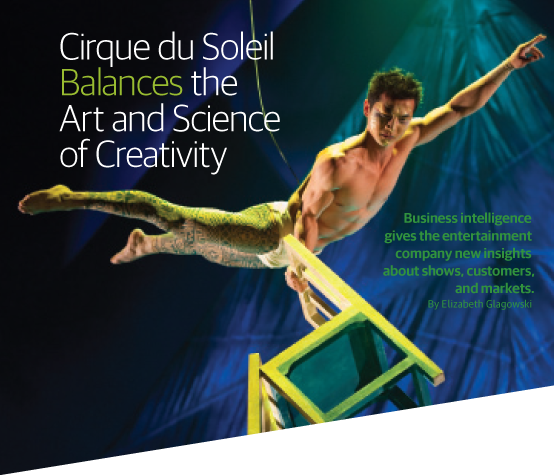




Balance. It’s a term that describes many of the amazing performances delivered by Cirque du Soleil. For 30 years, its troupes have traveled the world, mesmerizing audiences with an entertaining mix of theater, circus arts, dance, and drama. Behind the scenes, its balance transcends the performance space into the organization’s operations, as well. The company intertwines customer experience vision and data-driven decision making to strike a successful business balance.
The Montreal-based company operates both permanent and touring shows in more than 350 markets around the world, selling more than 10 million tickets annually. It is considered one of the leading innovative entertainment brands in the world. But market pressures meant the company couldn’t rest on its laurels. “Our competitors are growing and the financial crisis decreased consumers’ entertainment budgets,” says Axel Bedikyan, director of strategy and market intelligence. Cirque du Soleil competes not only with similar live events, but also with nearly any entertainment option for consumer dollars. “Creativity is our number one asset, but we need to know more to become better decision makers and validate our intuition.” It decided a more data-driven approach to business and the customer experience was critical.
Until recently, the company’s customer experience efforts were focused primarily on the actual performance. So the company began a full customer experience transformation that includes all areas that relate to the customer, not just the event. It is a multi-year initiative with executive support. “We’re looking at the customer experience more holistically,” Bedikyan says, creating a roadmap of enhancements. In particular, the company completed a business intelligence project earlier this year to expand data access to all in the company.
“The primary goal of the project was to render every person who wants information autonomous, and allow access and analysis companywide,” he says.
Cirque du Soleil has two main business units—its resident division and touring show division. Information relating to each department was collected and housed separately, sometimes on individual computers. “We had multiple versions of the truth,” Bedikyan says. It was difficult to aggregate and consolidate the information from the two units to get a full understanding of the big picture.
Bedikyan and his team integrated siloed information and added more detail to its database. Now, anyone in the company can analyze information related to the pre- and post-show experience via dashboards, as well as overall customer and market information. The “customer experience” moves beyond just the show to advertising, website activity, purchase information, customer interactions between purchase and the show, the actual show experience, exit surveys, and post-show follow-up, Bedikyan says. This level of data access allows the company to be more efficient and mitigate risk.
Cirque du Soleil now leverages data as it tracks the progress of a show. The marketing department, creative group, sales, finance, HR, and other departments all tap into data and analysis about which potential markets are most attractive to specific shows, which venues are the most appealing, what types of marketing strategies and pricing elements are needed, how sales figures compare to other shows and markets, and insights that come from free form customer comments. The tool gives employees access to information and insights and renders them autonomous in their use of the data. “We have access to maps and other tools to visualize data and allow business users to make data-driven decisions [with insight they didn’t have before],” he says. “Executives have the tools to make decisions about markets, consumer feedback, competition, and more.”
The customer feedback piece is especially important to keep the shows fresh and build a loyal fan base. “The essence of the show hasn’t disappeared,” Bedikyan says. “But we have data to make improvements and replicate positive aspects elsewhere,” though he declines to share specifics. He does note that departments that weren’t data savvy before, like the creative and quality assurance groups, are finding value in it.
Continuous flow and improvement
Like one of Cirque’s performances, the beauty of the program is in its constant movement. Bedikyan hopes that company leaders will think of creative ways to leverage the insight to further propel the customer experience and business operations. He says his team is starting to get requests for information about new types of analysis, but it’s still early in the program.
“We delivered the project, but it’s just the beginning,” he says. “New users will have new analysis needs. For it to remain relevant and interesting, it has to be a living thing.” Success will be built on how the tools enable the customer experience vision, not in the tools themselves. He says already hundreds of Cirque du Soleil’s 3,000 employees have begun accessing the data, and he is excited about the promise that comes from combining insights with creative and innovative minds.
One challenge that comes with data programs is interpretation. Every department looks at the data a little differently, and brings in their unique perspective (and sometimes bias). “You can show data to 10 different people, and they will interpret it 10 different ways,” Bedikyan says. To combat inconsistency, he advises that all stakeholders in a data-driven program get involved from the beginning. “Give everyone a seat at the table,” he says. That way common goals and interpretation can be decided from the start.
And like any enterprisewide initiative, change management is another roadblock to success. Bedikyan is encouraged by the pace of adoption so far. “Once people see what you’re delivering, you can do more,” he says. “Trying to do it all at once won’t work. With any project, until people see the program in action, no one will believe. That’s why it’s important to build on quick wins and case studies to evolve organically.”
Next steps include further refining the types of business intelligence analysis being done, and moving forward with new initiatives around the larger customer experience strategy. “We will continue to support decision making with information and insights,” he says, in tandem with Cirque’s creative endeavors and amazing feats of human performance. ![]()